|
 
Aug. 18, 2005
IN
THE NEWS | STAGE DOOR | ART BEAT
PREVIEW | THE HUM | CALENDAR

PLEASE ENTER
HERE: As the school year begins, HSU's enrollment crisis deepens
On the cover: Finishing touches on new entrance gate to Humboldt
State University,
Photo by Bob Doran.
by CAT SIEH
THE INTERSECTION OF LK WOOD
AND 14TH Street was never one of Arcata's main points of interest.
For years, just a small, wooden-plank sign with gold letters,
an example of the '70s-era architecture sprinkled across campus,
marked the entrance to Humboldt State University. Passers-by
might hardly have noticed.
But now, as the 2005-06 school
year begins, new HSU freshmen who happen to walk past will sure
as hell know where they will be going to school.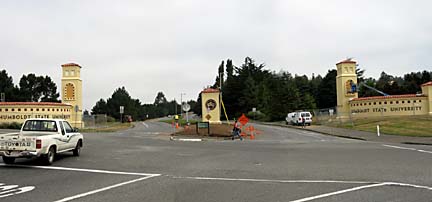
Rising from one side of the
formerly nondescript corner is a spanking new, 30-foot-tall,
three-part stucco gateway. Two maroon-topped towers, crafted
in the mission-style of the school's signature building, Founder's
Hall, border the north and south lanes of LK Wood. Curved, tan-colored
walls carry bold bronze letters that proudly announce "Humboldt
State University." In the median, another, smaller tower
presents a huge bronze university seal with an image of Founder's
Hall in its center.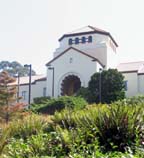
[Photo above:
New stucco gateway to HSU at the intersection of LK Wood
and 14th streets in Arcata. Photo at right: HSU Founder's Hall.]
This instant landmark, part
of a comprehensive Campus Wayfinding and Signage program that
aims to reshape HSU's image, began to take shape soon after students
left for summer vacation. Construction workers labored overtime
during the last few weeks to meet their deadline -- the first
day of the fall semester. In total, the project is expected to
cost around $350,000.
Why the rush, at such great
expense? Perhaps because HSU administrators needed to assure
themselves, and everyone else, that they are at least doing something
to address a looming crisis that could threaten the very future
of the institution.
HSU is in a double bind. It
faces pressure from the California State University system to
increase enrollment -- to attract and retain more students --
in order to better serve California's booming population. The
university would like to be able to spend money to recruit students
and keep them once they get here.
But money is tight. The CSU
system gives Humboldt State a certain amount of money each year
for every student it serves. But enrollment has been static,
at best, for many years. All the while, expenses like salaries,
health insurance and energy costs have been steadily increasing.
HSU needs to spend money to
make money, but it isn't making enough to spend.
At the same time, the CSU is
starting to demand results. Last year, for the first time, HSU
had to return $444,000 to the CSU after failing to meet its enrollment
target. (It wasn't alone: Not one of the 23 CSU campuses met
its enrollment target last year, returning $15.5 million total
to the CSU). In the past, such shortfalls were forgiven; the
schools kept the extra money.
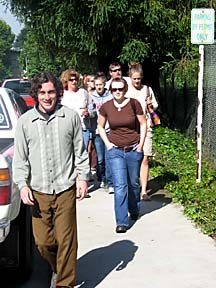 This year, the numbers are even worse; they are
actually headed in the other direction. On Monday, an HSU spokesperson
confirmed that the university would have only the equivalent
of 6,864 full-time students, down 166 students from the previous
year and devastatingly short of the CSU's target of 7,389. This year, the numbers are even worse; they are
actually headed in the other direction. On Monday, an HSU spokesperson
confirmed that the university would have only the equivalent
of 6,864 full-time students, down 166 students from the previous
year and devastatingly short of the CSU's target of 7,389.
The particulars of HSU's $95
million budget for the 2005-06 school year are still tentative.
Several campus officials said last week that the budget will
likely not be finalized until October. But reading the initial
draft, one thing becomes clear. The university is going to be
hard-pressed to strike a balance between funding an enrollment
drive and providing for current students. As it stands, any extra
money that goes to recruiting must come from elsewhere -- from
the budgets of academic departments, maintenance crews and other
support staff.
[Photo a left:James
Gibbons leads prospective students on a campus tour.]
And the enrollment drive --
guided by a Strategic Enrollment Committee that HSU President
Rollin Richmond organized last fall -- is extremely ambitious.
HSU plans to nearly double the size of its student body in 35
years; the target headcount is 12,000 students by the year 2040.
The university hopes to see a significant increase in enrollment
as early as fall 2006, when the target is 7,450 full-time-equivalent
students. The school spent $80,000 to hire college enrollment
consultants Noel-Levitz last fall to reshape the school's image
to attract and retain more students.
But offices key to enrollment
also say that they are not getting enough money in the new budget
to get the job done. Others on campus say that critical aspects
of the drive -- such as attracting more minority students, long
a campus goal -- are falling by the wayside.
Shortfall
When, in late July, Humboldt
State posted its preliminary budget for the upcoming academic
year on its web site, administrators throughout the university
were eager to understand what the implications were for their
departments. No one more so, perhaps, than those whose offices
are on the front lines of the enrollment battle.
In a letter accompanying the
budget, the university was quick to note that it had received
from the CSU a $5.8 million increase to its nearly $90 million
base budget. However, it noted later, subtracting increases to
mandatory expenses like health benefits, energy costs and union-negotiated
salary raises, HSU would really only have $133,500 in extra discretionary
funds.
The university budget committee,
which advises President Richmond on budget matters, recommended
that HSU give additional funding, totaling about $3 million,
to several specific programs, including several offices involved
in the enrollment drive, the letter said. To fund them, HSU would
have to reallocate almost $3 million from within the existing
budget, cutting from other departments.
But as the budget began to take
shape, most of the programs covered under the $3 million in "urgent
recommendations" from the budget committee found out that
they would not be receiving as much as they had asked for, or
as much as the budget committee had recommended.
The Office of Enrollment Management,
which includes the Financial Aid, Admissions and Registrar's
offices, will receive almost $200,000 less than it requested
for additional funding to its base budget for 2005-06. (Admissions
is in charge of recruiting first-time and transfer students.
The Registrar's Office is responsible for handling students who
have been accepted at HSU.)
Admissions Director Scott Hagg
said the cut will make it difficult to implement any of the recommended
changes to his office made by the HSU's consultants, Noel-Levitz,
this year.
University Advancement, the
donations and fundraising arm of HSU, will receive about $63,000
less than it requested, putting its budget at almost the same
level as last year and leaving little room to grow as expected
when it comes to enrollment.
Under Advancement's umbrella
is Public Affairs, HSU's publicity office. Public Affairs' operating
expenses budget (which excludes salaries) will take a cut from
$8,000 last year to $6,000 this year -- a 20 percent decrease.
The cut comes as the administration asks Public Affairs to play
an integral role in enrollment through marketing and publicity.
Interim Vice President of Advancement Burt Nordstrom said last
week that HSU expects the office to switch from a news bureau
model -- putting out press releases and communicating with reporters
-- to one more focused on marketing in one to five years.
Public Affairs Senior Communication
Officer Paul Mann said it would be tough to make the switch in
view of the recent cut, though the possibility remains that the
department could receive more funding in the fall, when the president
reviews committee reports on which Noel-Levitz recommendations
he should fund.
"Frankly, we were crippled
at $8,000," Mann said. "So a cut just makes the situation
worse."
Nordstrom said it remains to
be seen whether Advancement will have funding enough to hire
a vice president of marketing, as recommended by Noel-Levitz.
With budget details still pending, Nordstrom said he "wouldn't
even hazard a guess" as to when he will know if he can fill
the position.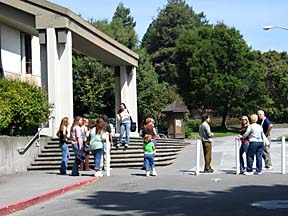
Bare bones
Even as the university attempts
to fully fund its enrollment/recruitment drive, departments charged
with the educational experience of HSU's current student body
are feeling the pinch.
The Office of Academic Affairs
initially requested just over $2 million in extra funding this
year; the money would be used to pay for lecturers, a new master's
degree program in social work and a summer semester, among other
things. In the end, the office received an increase of just $318,000.
Provost and Vice President of
Academic Affairs Rick Vrem said the slim budget will directly
affect class availability and the number of lecturers HSU will
be able to retain over the next year.
"It's going to be difficult
to offer a sufficient number of classes to meet enrollment demands
(in the spring)," Vrem said, "But we're going to try
to offer a bare bones schedule."
If HSU has to cut bac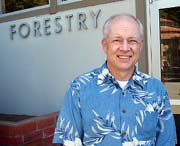 k
the number of classes it offers, students may not be able to
make timely progress toward their degrees, Vrem said. k
the number of classes it offers, students may not be able to
make timely progress toward their degrees, Vrem said.
[Photo at left:
Jim Howard, dean of the College of Natural Resources.]
The fate of HSU part-time instructors
is also unclear, though Vrem said that for now, there will be
no change in the status quo.
"For fall (2005), we'll
have about the same level of instructors as we saw this past
fall," Vrem said. "It is difficult to see what will
happen in the spring."
Jim Howard, dean of the College
of Natural Resources, said that he expects his budget to be meager.
"We're going to be scrambling
to find money to hire enough part-time faculty to be able to
offer the full range of courses that we'd like to offer,"
Howard said. "Everybody's hurting. That's pretty clear.
But if the academic side isn't adequately supported then nothing
else that we do matters much."
Of the five university divisions
included in the HSU budget, the Office of Administrative Affairs
was the only division to actually see its budget shrink from
the previous year. The division, which manages the university's
finances and its physical campus, lost $168,723.
University Budget Director Carol
Terry said Plant Operations, the department that maintains university
buildings and grounds, will most likely take the brunt of the
cut. Other Administrative Affairs offices, such as Fiscal Affairs,
cannot afford additional losses.
"Not only can they (Fiscal
Affairs) not take a cut, but they need more people," Terry
said.
With little funding left to
scrape from the existing budget, Terry said she expects Richmond
to allocate one-time funding this year to support enrollment.
Where will it come from? Terry said it is a definite possibility
that Richmond could take that money from the university reserves,
HSU's savings account.
Richmond already dipped into
the reserves once this year, Terry said, taking $383,000 "just
to keep from cutting more than he had to."
According to Terry, the reserves
totaled $1 million before Richmond made last year's withdrawal.
Just two and a half years earlier, when Terry came to HSU, the
university's reserves were empty. In Feb. '04, Terry helped create
a new budget policy, which gave $1 million to the reserves up
front, and committed to add about $30,000 each year, beginning
this year, until the reserves reached a healthy $2 million. But
with the budget tight as ever, Terry said HSU won't be able to
add to the reserves this year, as planned. She hopes to begin
adding to the reserves next year.
A missed opportunity?
But while crucial university
functions are squeezed to the breaking point in an attempt to
fund a marketing drive aimed at selling HSU to high school seniors,
some are saying the campus seems strangely reticent in addressing
perhaps the most crucial problem facing enrollment: the lack
of a diverse student body.
California, alone amongst the
United States, has a majority-minority population. No racial
group accounts for as much as half of California's people. The
Latino and Asian communities are booming. Yet Humboldt State
is still overwhelmingly white, and the university has a difficult
time attracting students of color.
HSU administrators acknowledge
that this is a problem. In his convocation speech last year,
Richmond identified diversity as "one of the most important
aspects of our vision."
The 1997 HSU Strategic Plan,
which was revised last fall, details the non-physical, administrative
changes HSU plans to execute in the next 35 years, noting in
plain language that "Humboldt State University will
increase the diversity of our students, faculty, staff and curriculum."
Five years later, in 2002, President
Richmond formed the Diversity Plan Steering Committee, charged
with gathering commentary and feedback in order to draft a campus
diversity plan.
Fast-forward another two years:
In April 2004, HSU released a 26-page draft dubbed the Diversity
Action Plan. The document outlines eight main goals and other
detailed suggestions to increase diversity and foster a more
tolerant social and institutional climate on campus.
Noel-Levitz's findings underscore
the importance of diversity to the enrollment effort. The firm
identified "limited appeal and access for students of color"
as one of HSU's main weaknesses; it further urged in the Marketing
and Recruitment Opportunities Analysis that the school should
"Focus on diversity as a critical market segment."
But an informal group of six
staff and faculty called the Staff of Color Collective (SOCC)
is concerned that the university's commitment to diversity is
superficial, lacking real action to make progress toward diversity.
In a private letter addressed
to President Richmond and the chairs of the Strategic Enrollment
Effort Advisory Committee, the group, which formed this spring,
criticizes both parties for what it calls a narrow-minded decision-making
process and lack of action in implementing steps toward a more
diverse campus.
The letter, dated July 8, noted
that the collective was disappointed with the process by which
the Strategic Enrollment Committee was selected, and challenges
"the efficacy of its input and recommendations."
"When the initial committee
was convened, there were no faculty, staff or administrators
of color invited to the table to partake in the discussions regarding
student retention and enrollment," wrote the collective
members, all of whom now sit on an enrollment advisory committee.
"It was only through pressure that these communities were
included we have tried to voice our opinions and present the
realities that we and our students face so that the university
can make the best possible action plan We feel our ideas are
not truly accepted as a credible part of the overall conversation
and as a result, feel that we were invited to the discussions
only to be regarded as tokens. It is time that our input, experiences
and knowledge be taken seriously if change and growth are to
occur at the HSU campus."
"Unless people from underrepresented/marginalized
communities are placed in positions called upon to make decisionshow
can you expect different outcomes?"
The letter offers enrollment
recommendations, including sections for recruitment, retention
and campus culture, but remains harsh in its criticism of the
strategic enrollment process. "It is obvious by the way
the conversations have been narrowly formed and directed, that
this university is not truly committed to bringing new and innovative
strategies to the table."
The group also compares the
large amount of data on diversity to the lack of action. It said
that the problem of HSU's lack of diversity had been noted in
many previous campus documents, dating back to 2001, but that
the administration had yet to seriously follow through.
"The implementation of
strategies requires the full support of leadership," the
letter reads. "Until now the support for diversity has been
mostly rhetoric without action."
Analysis paralysis
Earlier this year, a Noe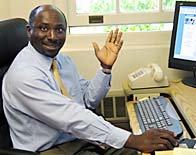 l-Levitz
report noted that a recurring theme at HSU was "analysis
paralysis." While there is a "desire to change,"
the report said, "little action takes place in order to
change retention and graduation rates." l-Levitz
report noted that a recurring theme at HSU was "analysis
paralysis." While there is a "desire to change,"
the report said, "little action takes place in order to
change retention and graduation rates."
The report, like the SOCC, calls
for action, and points out the similarities between the outcomes
of past studies and those done by Noel-Levitz. "The (retention)
plan developed during 2001 seemed to have great merit but was
never implemented This plan was a typical plan that Noel-Levitz
would have helped a university that had little or no planning
initiatives create. It should be revisited for 2005 and beyond
for implementation."
[Photo at left:
Guy-Alain Amoussou, director of international programs.]
The SOCC is not alone in its
skepticism. Guy-Alain Amoussou, director of international programs
and associate professor in computer sciences, agrees that much
of HSU's diversity effort is too much talk, not enough action.
"There is a lot of intent,"
Amoussou said. "But if good intentions are not followed
by clear and well-defined step-by-step action, then nothing will
happen in terms of improving diversity on campus."
Amoussou also noted that the
university must not only provide recommendations like those in
the Diversity Action Plan, but follow up to be sure they are
actually implemented.
"If there is no test plan
how can we credibly assess what we claim we want to implement
to improve the campus diversity?" Amoussou said. "What
is being planned to make sure that this Diversity Action Plan
doesn't stay on the shelf?"
The Diversity Action Plan, which
makes recommendations to be followed until 2009, has yet to be
finalized. Director of Diversity and Compliance Services Helen
Jones was out of town and unavailable to comment on when the
finished plan will be published and how many of the plan's suggestions
have been implemented so far.
Ethnic Studies Lecturer, EOP
Advisor and SOCC Member Ryan Mann-Hamilton said he could think
of only two of the plan's initiatives that have been carried
out: Last year's administrative diversity training, and the formation
of a Diversity Grant Funding Committee, which Mann-Hamilton sits
on.
"As our administrators
say, `Change is very slow to come to HSU,'" Mann-Hamilton
said. "If it's slow to come it's only because they haven't
implemented it. If it was something important to them they would
have done so already."
The SOCC expects to have a series
of meetings with Richmond over the coming semester, but, as the
letter suggests, the group wants the next step to be action.
Richmond was out of town and unavailable for comment, but Public
Affairs Director Jane Rogers said he is very concerned with the
group's letter and "really does want to take action."
In the meantime, the action
that HSU has taken over the summer has met with mixed reviews.
Nicknames for the new gateway abound: "Carl's Castles"
(named after a key administrator), "Schulz's Folly"
(after another), "The Golden Arches," "The Gun
Turrets," etc. Reviews have been decidedly mixed. In these
pages, one student has written that the gate's "Mission"
architecture insults the Native American victims of Spanish colonialism.
A local has decried it as a symbol of "LosAngelization."
The gateway was intended to
better define the boundaries of Humboldt State, to underline
that once someone crosses them she enters the sacred halls of
academe. It remains to be seen if enough people will make that
journey to keep the institution alive.
IN
THE NEWS | STAGE DOOR | ART BEAT
PREVIEW | THE HUM | CALENDAR
Comments? Write a
letter!

© Copyright 2005, North Coast Journal,
Inc.
|